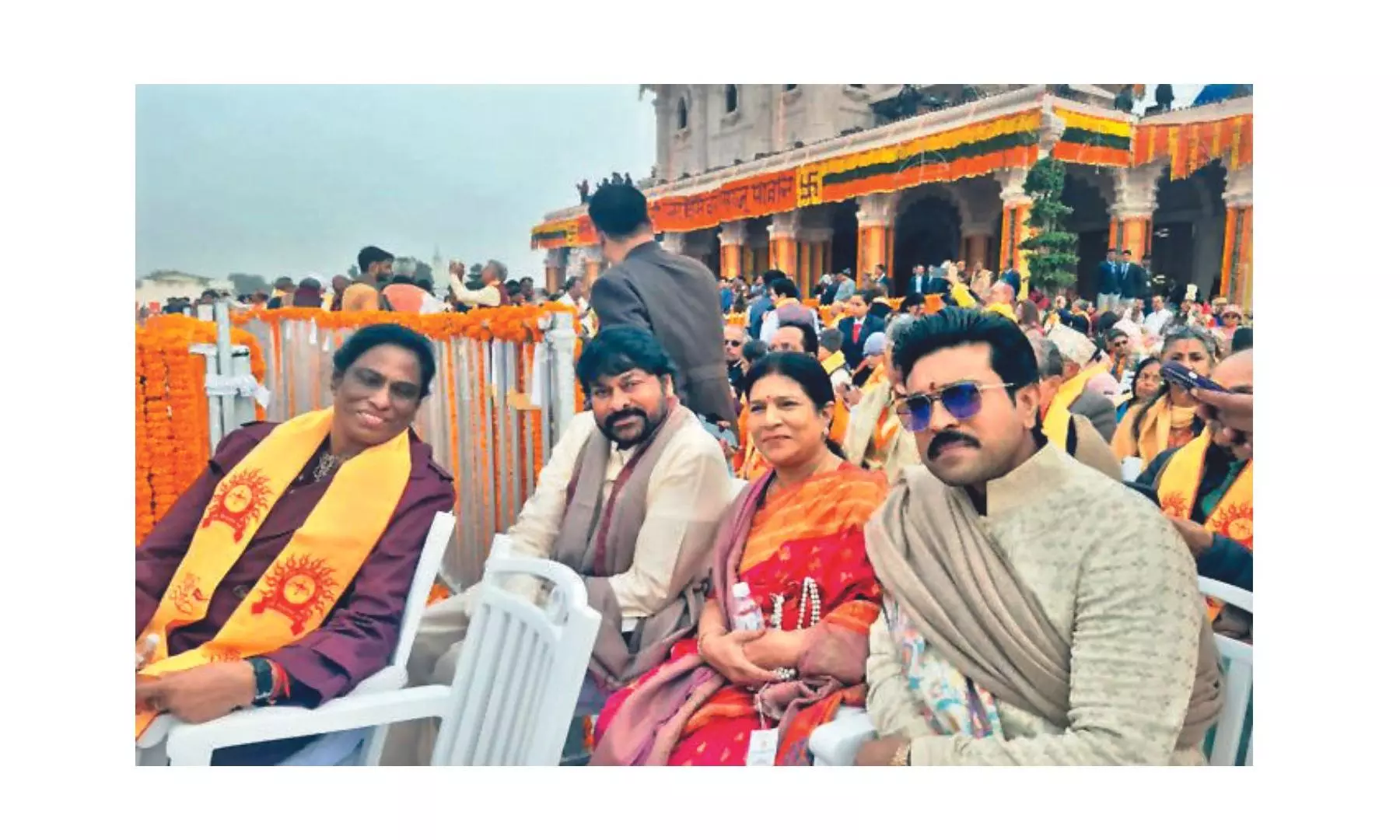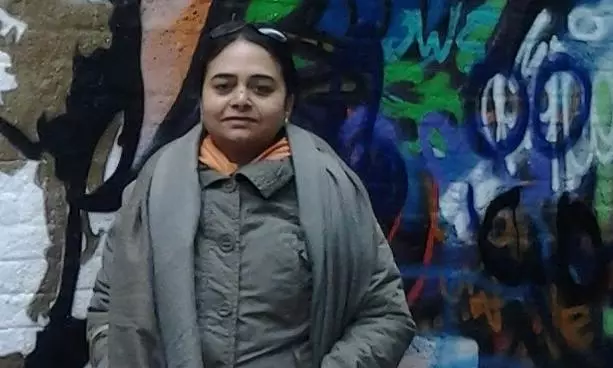On a Spiritual High
India witnesses a surge in spiritual tourism, with revenue expected to reach $59 billion by 2028, driven by post-pandemic search for inner peace and better connectivity to religious sites

Chiranjeevi family with P.T. Usha at Ayodhya Ram Mandir
The spiritual side of Indians was never this visible. The numbers prove it. Of late, spiritual tourism, or travel motivated by spiritual or religious beliefs, is at an all-time high. People are flocking to religious monuments and destinations, as well as spiritually uplifting locations, like never before.
According to the most recent estimates, religious and spiritual tourism account for more than 60% of total tourism in India. The sector is expected to generate $59 billion in revenue by 2028, with 140 million temporary and permanent job opportunities established by 2030. So what’s boosting spiritual tourism?
Unwind & reconnect
“If not now, then when, and if not in India, then where else would spiritual tourism flourish?” smiles Nikhil Kapur, co-founder and co-director of Atmantan Wellness Centre. “In today’s time of high stress, conflicts, etc., many travellers seek experiences that go beyond sightseeing and connect with their inner selves. Spiritual tourism in India offers a chance to unwind and reconnect with oneself through yoga retreats, meditation practices, and visits to pilgrimage sites,” points out Nikhil.
Unwind & reconnect
“If not now, then when, and if not in India, then where else would spiritual tourism flourish?” smiles Nikhil Kapur, co-founder and co-director of Atmantan Wellness Centre. “In today’s time of high stress, conflicts, etc., many travellers seek experiences that go beyond sightseeing and connect with their inner selves. Spiritual tourism in India offers a chance to unwind and reconnect with oneself through yoga retreats, meditation practices, and visits to pilgrimage sites,” points out Nikhil.
He says destinations that have maximum spiritual significance are being developed so that travellers can get a good experience and continue their spiritual journey. The consecration of the Lord Ram temple in Ayodhya exemplifies this significant growth of spiritual tourism in India,” he says.
The post-pandemic era has only fueled this trend, as crises often provoke a deeper search for spiritual connections, feels Nikhil. “Our Prime Minister Narendra Modi is leading by example. He is reaching out to people so that they become more aware of what our ancient valuable scriptures stand for, as there is a lot of ignorance or wrong information around all of this,” feels Nikhil.
Journeying towards deeper connections
The media’s portrayals of India’s spiritual destinations and practices have also sparked interest among domestic as well as international travellers.
“For overseas travellers too, India is the birthplace of Yoga, Vedanta, and Ayurveda, and this has enormous potential to attract people seeking authentic spiritual experiences,” adds Nikhil.
Recalling one experience while traversing Vietnam a few months ago, Nikhil says his guide paid him a respectful bow, stating that it was because Buddhism traces its origins back to India.
Travel Predictions
According to travel predictions for 2023, nearly 70% of Indian tourists attempted a spiritual stay, which includes meditation and mindfulness retreats, while 63% went on quiet retreats. In 2022, religious tourism drew 1439 million visitors and generated `1.34 lakh billion in revenue for its destinations, according to Ministry of Tourism data.
Covid insecurity
Radhika Khanijo, private travel designer, founder, and managing director, Welgrow Travels Pvt. Ltd., feels the insecurity of COVID times has changed the tourism sector completely.
“The insecurities, mental health, fast life, and technology are taking common man towards spiritualism and finding solace. Moreover, the connectivity to all cities where temples and shrines are located has increased,” says Radhika.
She says post-pandemic, devotees and tourists, including NRIs, have been flocking shrines across India to express their gratitude. “PM Modi has done amazing work in getting corridors made at temples like Kashi Vishwanath. The Ram temple in Ayodhya is another destination that is attracting crowds,” she says, adding that more and more people are visiting the 12 Jyotirlinga’s, Vaishno Devi, Golden Temple, Shirdi, and Char Dham.
Better connectivity
Daaji (Kamlesh D. Patel), Guide of Heartfulness and President of Shri Ram Chandra Mission says, a boost in infrastructure at spiritual and religious places is the main reason.
“There are new airports in the pipeline with better connectivity and accessibility by road, rail, or air. The infrastructure has improved tremendously, and technology is connecting cities through tiers 1, 2, 3, and 4,” he feels. This, in turn, generates more livelihoods and creates an ecosystem as an economic booster.
“This is a remarkable time for the tourism sector, with visitors globally who want to come to India to explore and benefit from spiritual tourism here,” says Daaji.
spiritual renaissance
Rajesh Shukla, Chief Strategist, National Intellectual Advisory feels, the tourism scenario in India before Shri Ram Mandir in Ayodhya was such that Kerala ranked first as its total revenue (including direct and indirect) from tourism during 2022 was `35168.42 crore, showing an increase of 186.25% over the last year’s figure. This is followed by Goa, where more than 4.03 lakh tourists visit.
“If you talk about religious tourism, the Golden Temple is in the top place, generating 3.5 lakh devotees per day, followed by Tirupati, which has 2/2.5 lakh devotees per day. Vaishnodevi temple is visited by 75,000 devotees per day, while Varanasi gets a footfall of 60–70 thousand devotees per day,” he informs.
Post the consecration of Ram Mandir, the number of tourists has gone up to 5 lakh per day in Ayodhya. “It is expected to reach six crores by the end of the year. The entire scenario of the tourism industry in Ayodhya has changed considerably, as it is estimated to cross $6 trillion in the next five years,” says Rajesh.
Ayodhya had already been attracting many tourists because of its ancient temples and historical places, such as Hanuman Garhi and Kanak Bhavan, before this grand structure came into being.
Journeying towards deeper connections
The media’s portrayals of India’s spiritual destinations and practices have also sparked interest among domestic as well as international travellers.
“For overseas travellers too, India is the birthplace of Yoga, Vedanta, and Ayurveda, and this has enormous potential to attract people seeking authentic spiritual experiences,” adds Nikhil.
Recalling one experience while traversing Vietnam a few months ago, Nikhil says his guide paid him a respectful bow, stating that it was because Buddhism traces its origins back to India.
Travel Predictions
According to travel predictions for 2023, nearly 70% of Indian tourists attempted a spiritual stay, which includes meditation and mindfulness retreats, while 63% went on quiet retreats. In 2022, religious tourism drew 1439 million visitors and generated `1.34 lakh billion in revenue for its destinations, according to Ministry of Tourism data.
Covid insecurity
Radhika Khanijo, private travel designer, founder, and managing director, Welgrow Travels Pvt. Ltd., feels the insecurity of COVID times has changed the tourism sector completely.
“The insecurities, mental health, fast life, and technology are taking common man towards spiritualism and finding solace. Moreover, the connectivity to all cities where temples and shrines are located has increased,” says Radhika.
She says post-pandemic, devotees and tourists, including NRIs, have been flocking shrines across India to express their gratitude. “PM Modi has done amazing work in getting corridors made at temples like Kashi Vishwanath. The Ram temple in Ayodhya is another destination that is attracting crowds,” she says, adding that more and more people are visiting the 12 Jyotirlinga’s, Vaishno Devi, Golden Temple, Shirdi, and Char Dham.
Better connectivity
Daaji (Kamlesh D. Patel), Guide of Heartfulness and President of Shri Ram Chandra Mission says, a boost in infrastructure at spiritual and religious places is the main reason.
“There are new airports in the pipeline with better connectivity and accessibility by road, rail, or air. The infrastructure has improved tremendously, and technology is connecting cities through tiers 1, 2, 3, and 4,” he feels. This, in turn, generates more livelihoods and creates an ecosystem as an economic booster.
“This is a remarkable time for the tourism sector, with visitors globally who want to come to India to explore and benefit from spiritual tourism here,” says Daaji.
spiritual renaissance
Rajesh Shukla, Chief Strategist, National Intellectual Advisory feels, the tourism scenario in India before Shri Ram Mandir in Ayodhya was such that Kerala ranked first as its total revenue (including direct and indirect) from tourism during 2022 was `35168.42 crore, showing an increase of 186.25% over the last year’s figure. This is followed by Goa, where more than 4.03 lakh tourists visit.
“If you talk about religious tourism, the Golden Temple is in the top place, generating 3.5 lakh devotees per day, followed by Tirupati, which has 2/2.5 lakh devotees per day. Vaishnodevi temple is visited by 75,000 devotees per day, while Varanasi gets a footfall of 60–70 thousand devotees per day,” he informs.
Post the consecration of Ram Mandir, the number of tourists has gone up to 5 lakh per day in Ayodhya. “It is expected to reach six crores by the end of the year. The entire scenario of the tourism industry in Ayodhya has changed considerably, as it is estimated to cross $6 trillion in the next five years,” says Rajesh.
Ayodhya had already been attracting many tourists because of its ancient temples and historical places, such as Hanuman Garhi and Kanak Bhavan, before this grand structure came into being.
( Source : Deccan Chronicle )
Next Story

